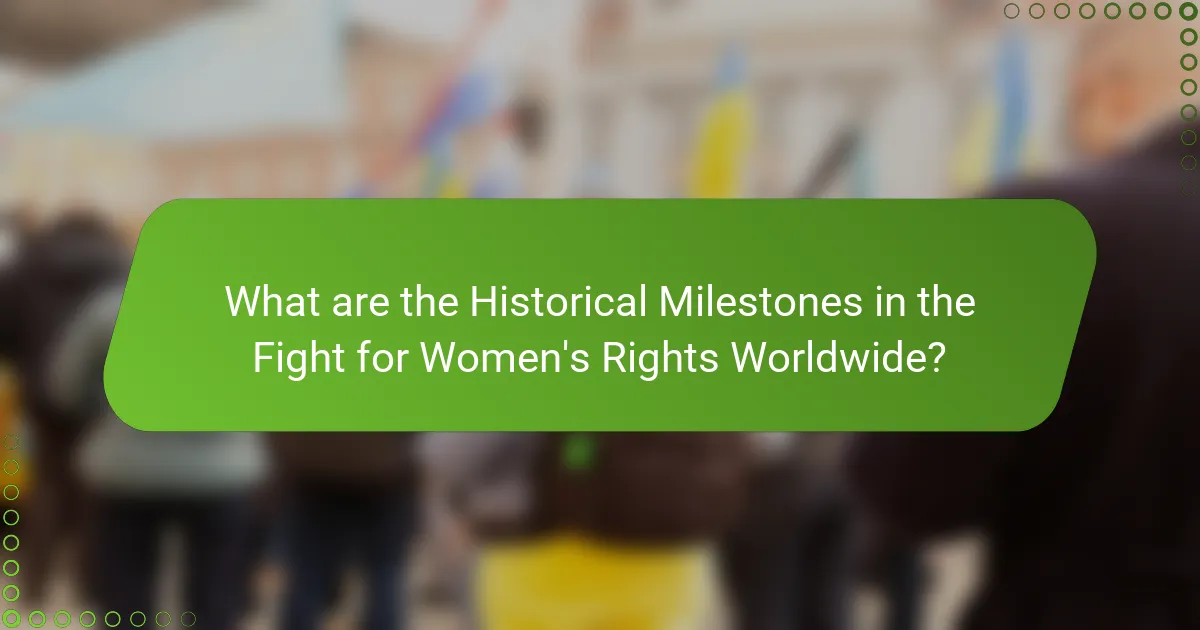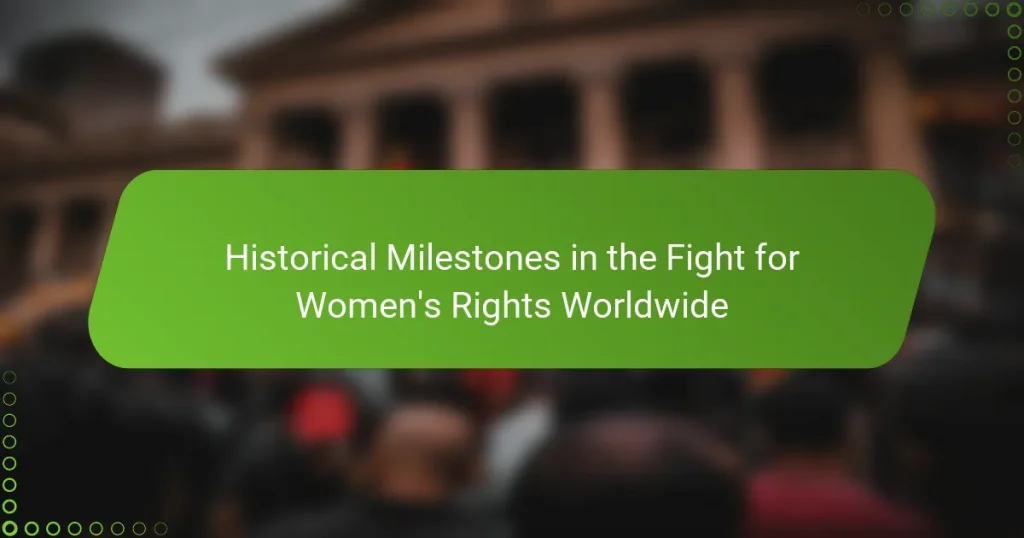The article focuses on the historical milestones in the fight for women’s rights worldwide, highlighting key events that have shaped the pursuit of gender equality. Significant moments include the 1848 Seneca Falls Convention, which initiated the women’s rights movement in the U.S., and the passage of the 19th Amendment in 1920, granting women the right to vote. The global recognition of women’s rights as human rights began with the Universal Declaration of Human Rights in 1948, followed by the adoption of the CEDAW in 1979, which established international standards for women’s rights. The Beijing Declaration and Platform for Action in 1995 further advanced the global agenda for women’s empowerment. These milestones collectively underscore the ongoing struggle for gender equality and the progress achieved over time.

What are the Historical Milestones in the Fight for Women’s Rights Worldwide?
The historical milestones in the fight for women’s rights worldwide include significant events that shaped gender equality. In 1848, the Seneca Falls Convention marked the beginning of the women’s rights movement in the United States. This event produced the Declaration of Sentiments, which demanded equal rights for women. In 1920, the 19th Amendment granted women in the U.S. the right to vote, a major achievement in suffrage. The Universal Declaration of Human Rights in 1948 recognized women’s rights as human rights globally. The 1979 Convention on the Elimination of All Forms of Discrimination Against Women (CEDAW) was adopted by the United Nations, establishing international standards for women’s rights. In 1995, the Beijing Declaration and Platform for Action set a global agenda for advancing women’s rights and empowerment. These milestones illustrate the ongoing struggle for gender equality and the progress made over time.
How did the fight for women’s rights begin globally?
The fight for women’s rights began globally in the late 19th and early 20th centuries. Key movements emerged in various countries advocating for suffrage and social reforms. In 1848, the Seneca Falls Convention in the United States marked a significant milestone. This gathering produced the Declaration of Sentiments, demanding equal rights for women. In the UK, the suffragette movement gained momentum in the early 1900s. Women campaigned for voting rights and legal equality. Globally, these movements inspired similar efforts in other nations. By the early 20th century, women’s rights activism had spread to countries like New Zealand and Australia, leading to significant legislative changes.
What were the early movements advocating for women’s rights?
The early movements advocating for women’s rights include the Seneca Falls Convention of 1848 and the suffragist movement. The Seneca Falls Convention was the first women’s rights convention in the United States. It produced the Declaration of Sentiments, which outlined grievances and called for equal rights. The suffragist movement sought to secure women’s right to vote. Key figures included Susan B. Anthony and Elizabeth Cady Stanton. Their efforts led to the eventual passage of the 19th Amendment in 1920, granting women the right to vote in the United States.
Who were the key figures in the early women’s rights movements?
Key figures in the early women’s rights movements included Elizabeth Cady Stanton, Susan B. Anthony, and Lucretia Mott. Elizabeth Cady Stanton was instrumental in organizing the Seneca Falls Convention in 1848. This event marked the beginning of the women’s rights movement in the United States. Susan B. Anthony worked alongside Stanton and played a crucial role in advocating for women’s suffrage. Lucretia Mott was a prominent abolitionist who also fought for women’s rights. These individuals helped lay the groundwork for future advancements in women’s rights. Their efforts contributed to significant changes in laws and societal attitudes regarding gender equality.
What major events have shaped women’s rights throughout history?
The major events that have shaped women’s rights throughout history include the Seneca Falls Convention of 1848, which marked the beginning of the women’s rights movement in the United States. This convention produced the Declaration of Sentiments, outlining the grievances and demands of women. The suffrage movement in the early 20th century led to women gaining the right to vote in many countries. For example, the 19th Amendment was ratified in the U.S. in 1920, granting women suffrage. The United Nations’ adoption of the Convention on the Elimination of All Forms of Discrimination Against Women (CEDAW) in 1979 established international standards for women’s rights. The feminist movements of the 1960s and 1970s also played a crucial role in advocating for gender equality and reproductive rights. Additionally, the #MeToo movement, which gained traction in 2017, highlighted the prevalence of [censured] harassment and assault, pushing for systemic change. Each of these events contributed significantly to advancing women’s rights and altering societal perceptions.
What significant legislation has been passed to promote women’s rights?
The significant legislation passed to promote women’s rights includes the Voting Rights Act of 1965. This act aimed to eliminate barriers to voting for African American women and men. It prohibited racial discrimination in voting practices. Another important law is the Equal Pay Act of 1963. This legislation mandates equal pay for equal work, regardless of gender. The Title IX of the Education Amendments of 1972 prohibits gender discrimination in federally funded education programs. The Violence Against Women Act of 1994 provides legal protections for victims of domestic violence. Each of these laws has played a crucial role in advancing women’s rights.
How have international treaties impacted women’s rights advocacy?
International treaties have significantly advanced women’s rights advocacy by establishing legal frameworks and international standards. Treaties like the Convention on the Elimination of All Forms of Discrimination Against Women (CEDAW) have set benchmarks for gender equality. CEDAW, adopted in 1979, obligates signatory nations to eliminate discrimination against women. This treaty has catalyzed national laws and policies that promote women’s rights.
Additionally, international treaties have facilitated global dialogue and collaboration among nations. They provide a platform for sharing best practices and strategies in women’s rights advocacy. Reports from the United Nations indicate that countries adhering to CEDAW have made measurable progress in women’s political participation and access to education. Furthermore, international treaties have empowered grassroots organizations by providing them with tools to hold governments accountable.
The impact of these treaties is evident in the increased visibility of women’s issues on the global stage. Advocacy efforts have led to the recognition of women’s rights as human rights. This shift has influenced national legislation and public policies worldwide, fostering an environment conducive to gender equality.
What role did social movements play in advancing women’s rights?
Social movements were crucial in advancing women’s rights. They mobilized individuals and communities to advocate for gender equality. Movements like suffrage campaigns in the early 20th century led to women gaining the right to vote. The Women’s Liberation Movement of the 1960s and 1970s challenged societal norms and fought for reproductive rights. These movements raised awareness of issues such as domestic violence and workplace discrimination. They influenced legislation, resulting in laws that protect women’s rights. For instance, Title IX in 1972 prohibited gender discrimination in education. Social movements provided a platform for women’s voices, fostering solidarity and activism worldwide.
What are some notable grassroots movements for women’s rights?
Notable grassroots movements for women’s rights include the Women’s Suffrage Movement and the #MeToo Movement. The Women’s Suffrage Movement sought voting rights for women, achieving significant milestones in the early 20th century. In the United States, the 19th Amendment was ratified in 1920, granting women the right to vote. The #MeToo Movement began in 2006, raising awareness about [censured] harassment and assault. It has empowered countless women to share their experiences and demand accountability. Both movements have had a lasting impact on women’s rights globally.
How did the suffrage movement influence women’s rights globally?
The suffrage movement significantly advanced women’s rights worldwide. It established the principle that women deserve equal political representation. The movement led to the first legal voting rights for women in countries like New Zealand in 1893. This inspired global movements, encouraging women to fight for their rights in various nations. Many countries followed suit, granting suffrage in the early 20th century. The movement also highlighted issues such as education and employment rights. It laid the groundwork for future feminist movements. The suffrage movement’s legacy continues to influence women’s rights discussions today.
How have cultural and societal changes influenced the fight for women’s rights?
Cultural and societal changes have significantly influenced the fight for women’s rights. Movements advocating for gender equality emerged in response to changing societal norms. The suffragette movement in the early 20th century exemplified this shift as women sought voting rights. The 1960s and 1970s women’s liberation movement marked a pivotal cultural change, emphasizing equal pay and reproductive rights.
The rise of feminist literature and activism brought awareness to gender discrimination. Legal reforms, such as the Equal Pay Act of 1963 in the U.S., were direct results of these societal pressures. Globalization and social media have further amplified women’s voices, facilitating international solidarity. Cultural shifts towards recognizing diversity and intersectionality have also enriched the discourse on women’s rights. These changes collectively propelled the advancement of women’s rights across various societies.
What impact did the feminist waves have on women’s rights?
The feminist waves significantly advanced women’s rights globally. The first wave, occurring in the late 19th and early 20th centuries, focused on legal issues and inequalities, particularly suffrage. This movement resulted in women gaining the right to vote in many countries, including the U.S. in 1920. The second wave, emerging in the 1960s and 1970s, expanded the fight to include issues like workplace equality, reproductive rights, and [censured] liberation. This led to landmark legislation, such as the Equal Pay Act of 1963 in the U.S. The third wave, beginning in the 1990s, emphasized diversity and intersectionality within feminism. This wave challenged traditional gender roles and promoted the rights of marginalized women. Collectively, these feminist waves reshaped societal norms, influenced policies, and fostered a greater awareness of gender equality.
How have different cultures approached women’s rights issues?
Different cultures have approached women’s rights issues in varied ways based on historical, social, and religious contexts. In Western societies, the suffrage movement in the late 19th and early 20th centuries marked significant progress. Women gained the right to vote in countries like the United States in 1920 and the United Kingdom in 1928. In contrast, many Middle Eastern cultures have faced challenges due to traditional and religious norms. For instance, Saudi Arabia granted women the right to drive only in 2018, reflecting a gradual shift.
In India, women’s rights movements have focused on issues like education and legal rights, with the Hindu Succession Act of 1956 improving inheritance rights. African nations have shown diverse approaches; for example, Rwanda has one of the highest rates of female representation in government, largely due to policies post-genocide. In contrast, some regions continue to struggle with gender-based violence and discrimination.
These examples illustrate how cultural, political, and historical factors shape women’s rights across the globe. The differences highlight the ongoing fight for equality in various contexts.
What challenges have persisted in the fight for women’s rights?
Systemic discrimination remains a significant challenge in the fight for women’s rights. Women continue to face unequal pay for equal work, with the global gender pay gap estimated at 16%. Access to education is still limited in many regions, particularly for girls in developing countries. Violence against women, including domestic abuse and [censured] harassment, persists as a widespread issue. Legal barriers also hinder women’s rights, as many countries still lack comprehensive laws against gender-based discrimination. Cultural norms often reinforce gender inequality, making progress difficult. Political representation remains low, with women holding only 26% of parliamentary seats globally. Reproductive rights are under threat in various jurisdictions, affecting women’s autonomy over their bodies. These challenges indicate that the fight for women’s rights is ongoing and requires continued advocacy and action.
What are the ongoing barriers to achieving gender equality?
Ongoing barriers to achieving gender equality include systemic discrimination, cultural norms, and economic disparities. Systemic discrimination manifests in laws and policies that disadvantage women. For example, women often face legal obstacles in areas like inheritance and property rights. Cultural norms perpetuate stereotypes that limit women’s roles in society. This can lead to resistance against women’s empowerment initiatives. Economic disparities create unequal access to resources and opportunities. Women globally earn approximately 60-75% of men’s wages for similar work. Additionally, violence against women remains prevalent, hindering their participation in public life. These barriers collectively sustain gender inequality across various sectors.
How do intersectionality and diversity affect women’s rights movements?
Intersectionality and diversity significantly shape women’s rights movements by highlighting the varied experiences of women. Intersectionality recognizes that women face overlapping forms of discrimination based on race, class, sexuality, and ability. This understanding leads to more inclusive advocacy efforts. For example, movements that address issues faced by women of color often advocate for policies that consider systemic racism alongside gender inequality.
Diversity within women’s rights movements promotes a broader range of perspectives. This inclusivity helps identify unique challenges faced by different groups of women. Research shows that organizations with diverse leadership are more effective in addressing complex social issues. For instance, the inclusion of diverse voices has led to the development of tailored solutions for marginalized communities.
Overall, intersectionality and diversity enhance the effectiveness and relevance of women’s rights movements, ensuring that the needs of all women are represented and addressed.
What can be learned from the historical milestones in the fight for women’s rights?
Historical milestones in the fight for women’s rights reveal the evolution of gender equality. They illustrate the persistent struggle for legal recognition and social justice. Key events, such as the Seneca Falls Convention in 1848, marked the formal beginning of the women’s rights movement in the United States. The suffrage movement led to women gaining the right to vote in many countries, highlighting the importance of political participation. The 1963 Equal Pay Act in the U.S. addressed wage discrimination, emphasizing economic equality. These milestones show how activism can lead to significant societal changes. They also demonstrate the interconnectedness of women’s rights with broader human rights issues. Understanding this history informs current efforts for gender equality and inspires continued advocacy.
How can past successes inform current women’s rights advocacy?
Past successes in women’s rights advocacy provide valuable lessons and frameworks for current efforts. Historical milestones, such as the suffrage movement, illustrate effective strategies like grassroots organizing and coalition-building. These successes highlight the importance of persistent advocacy in achieving legislative changes. For instance, the passage of the 19th Amendment in the United States in 1920 expanded voting rights for women. This achievement demonstrates how mobilizing public support can influence political action. Additionally, past movements have established legal precedents that current advocates can leverage. The Equal Pay Act of 1963 serves as a foundation for ongoing wage equality campaigns. Understanding these historical contexts allows contemporary advocates to refine their approaches and anticipate challenges. Overall, past achievements inform current strategies by showcasing successful tactics and underscoring the need for sustained engagement.
What best practices can be adopted from historical movements?
Best practices from historical movements include grassroots organizing, coalition building, and strategic communication. Grassroots organizing mobilizes communities and empowers individuals. For example, the suffragette movement effectively used local chapters to drive national change. Coalition building unites diverse groups for a common cause. The Civil Rights Movement successfully brought together various organizations to combat racial injustice. Strategic communication ensures clear messaging and widespread awareness. The Women’s March in 2017 used social media to amplify its message globally. These practices have proven effective in creating lasting social change.
The main entity of the article is the historical milestones in the fight for women’s rights worldwide. The article outlines significant events that have shaped gender equality, beginning with the Seneca Falls Convention in 1848 and progressing through key achievements such as the ratification of the 19th Amendment in 1920 and the adoption of CEDAW in 1979. It highlights the roles of key figures, early movements, and international treaties that have influenced women’s rights advocacy. Additionally, the article addresses ongoing challenges and barriers to achieving gender equality, emphasizing the importance of understanding historical contexts to inform current advocacy efforts.




